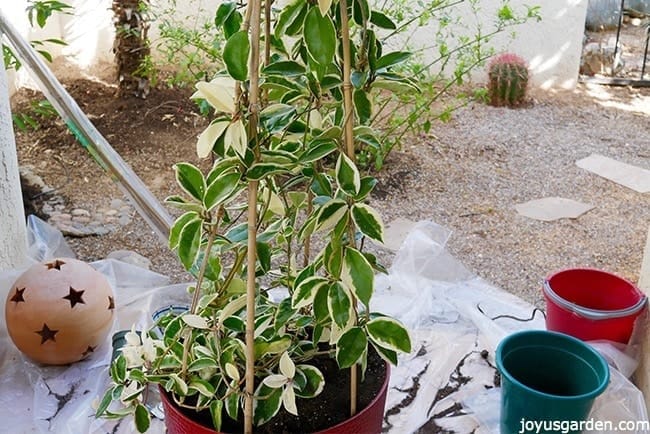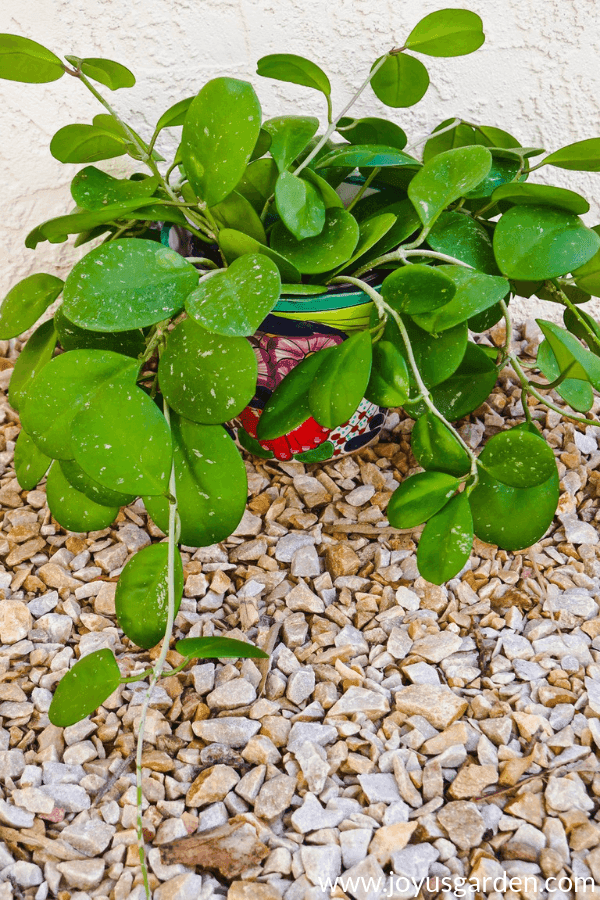Repotting My Large Hoya Topiary
Oh my goodness, how I do love Hoyas! They’re such an easy and attractive houseplant to grow and when they flower, even more sweet. I had trained this plant on bamboo hoops 2 years ago and it has since grown like crazy. Time to spring into action and get to repotting my large Hoya topiary.
This Hoya carnosa variegata, which I bought in a 4″ pot years ago at Roger’s Gardens (a must visit nursery if you’re in or visiting the Orange County, CA area), came with me when I moved from California to Arizona last summer. It grew outdoors in Santa Barbara and does the same here in Tucson, except for 2 colder winter months which it spent in the garage.
I had repotted it twice and needed to do it again as the low bowl was way too small and the 40″ hoops were flip-flopping every which way. Shame on me, that’s no way to treat a plant you adore!
Some Of Our General Houseplant Guides For Your Reference:
- 3 Ways To Successfully Fertilize Indoor Plants
- How to Clean Houseplants
- Winter Houseplant Care Guide
- Plant Humidity: How I Increase Humidity For Houseplants
- Buying Houseplants: 14 Tips For Indoor Gardening Newbies
- 11 Pet-Friendly Houseplants
Repotting my Large Hoya topiary on the side patio:
Materials I used:
Most Hoyas, aka Wax Plants, are epiphytic and love a rich mix with excellent drainage. All the mixes and amendments listed below are organic. You can see the portions I used in the video.
Potting Soil. I’m partial to Ocean Forest because of its high-quality ingredients. It’s a soilless mix & is enriched with lots of good stuff but also drains well. It’s great for container planting, including houseplants.
Succulent & Cactus Mix. Here’s the recipe for the mix I use.
If you don’t want to make your own, these are available online: Bonsai Jack (this 1 is very gritty; great for those prone to overwatering!), Hoffman’s (this is more cost effective if you have a lot of succulents but you might have to add pumice or perlite), or Superfly Bonsai (another fast draining 1 like Bonsai Jack which is great for indoor succulents).
Compost. I used Tank’s local compost. Give Dr. Earth’s a try if you can’t find any where you live. Both enrich the soil naturally.
Orchid Bark. Epiphytes love orchid back.
Worm Compost. This is my favorite amendment, which I use sparingly because it’s rich. I’m currently using Worm Gold Plus. Here’s why I like it so much.
Coco Coir. This environmentally friendly alternative to peat moss is pH neutral, increases nutrient holding capacity & improves aeration.

Here’s the Hoya right after I transplanting. It needed straightening & stabilizing but I’m thankful I got it in the pot without all coming apart.
4′ Bamboo Stakes. I used these to stabilize the hoops in the tall container – you’ll see what I did in the video.
Fishing Line. To tie the stakes to the hoops.
30″ Tall Resin Planter. It was a sand color & I sprayed it with 2 colors red gloss paint.
By the way, these are just like the 40″ Bamboo Hoops I used a couple of years ago to train this Hoya. The apron I’m wearing in the 2nd half of the video is one that we design and manufacture. It’s a great denim work apron with lots of pockets; plus, it’s cute too.

This is how the Hoya looked when I transplanted & trained it 2 years ago, back in Santa Barbara. How small & pale it was!
I said in the video that I didn’t want this plant to get any taller but I think I’ve changed my mind. It sits right outside the sliding glass door in my living room and the plant and jazzy red pot are very eye catching. I can see it from the dining room and kitchen too – it makes me happy when I look at it.
I’m going to keep my eye open for a couple of 60″ hoops and add them in as the plant really starts to trail. Oh no, I think I need (want?!) more Hoyas too!
Here’s a post and video on Hoya care which I hope you find useful. I’ve a couple of updated Hoya care posts – this 1 on growing a Hoya as a houseplant and another on growing a Hoya outdoors.
They’re wonderful houseplants, and as you can see, take to training very well. Have you trained any Hoyas? If so, please share how. Inquiring horticultural minds want to know!
Happy gardening & thanks for stopping by,

YOU MAY ALSO ENJOY:
- Repotting Basics: Basics Beginning Gardeners Need To Know
- 15 Easy To Grow Houseplants
- A Guide To Watering Indoor Plants
- 7 Easy Care Floor Plants For Beginning Houseplant Gardeners
- 10 Easy Care Houseplants For Low Light

This post may contain affiliate links, you can read our policies here.
- About the Author
- Latest Posts
Nell, the founder of Joy Us garden, was born into a gardening family and grew up in Connecticut’s countryside. After living in Boston, New York, San Francisco, & Santa Barbara, she now calls the Arizona desert home. She studied horticulture & garden design, working in the field all her life. Nell is a gardener, designer, blogger, Youtube creator, & author. She’s been gardening for a very long time & wants to share what she’s learned with you.






I am interested in the mix you use for your hoyas: you provided your list of ingredients,but I don’t have any idea about the approximate proportions of each ingredient. Do you have this maybe already documented in an other video? Thanks.
Hi Jacques – Here’s the approximate ratio I use: 1/3 potting soil & 1/3 succulent & cactus mix. The remaining 1/3 is composed of equal parts compost, orchid bark & coco coir. Worm compost is pretty strong so I sprinkle in a few handfuls around the sides of the root ball & then a thin layer (1/2″) on top. Nell
The re-potting video is so helpful!
I am new to hoyas, but inherited a very large one (that I adore)…after watching this, I successful re-potted it with little trauma!
Thank you!
You are certainly welcome! I was living 7 blocks away from the beach & I now live in the desert. My hoyas have made the adjustment beautifully – they’re great plants. Nell